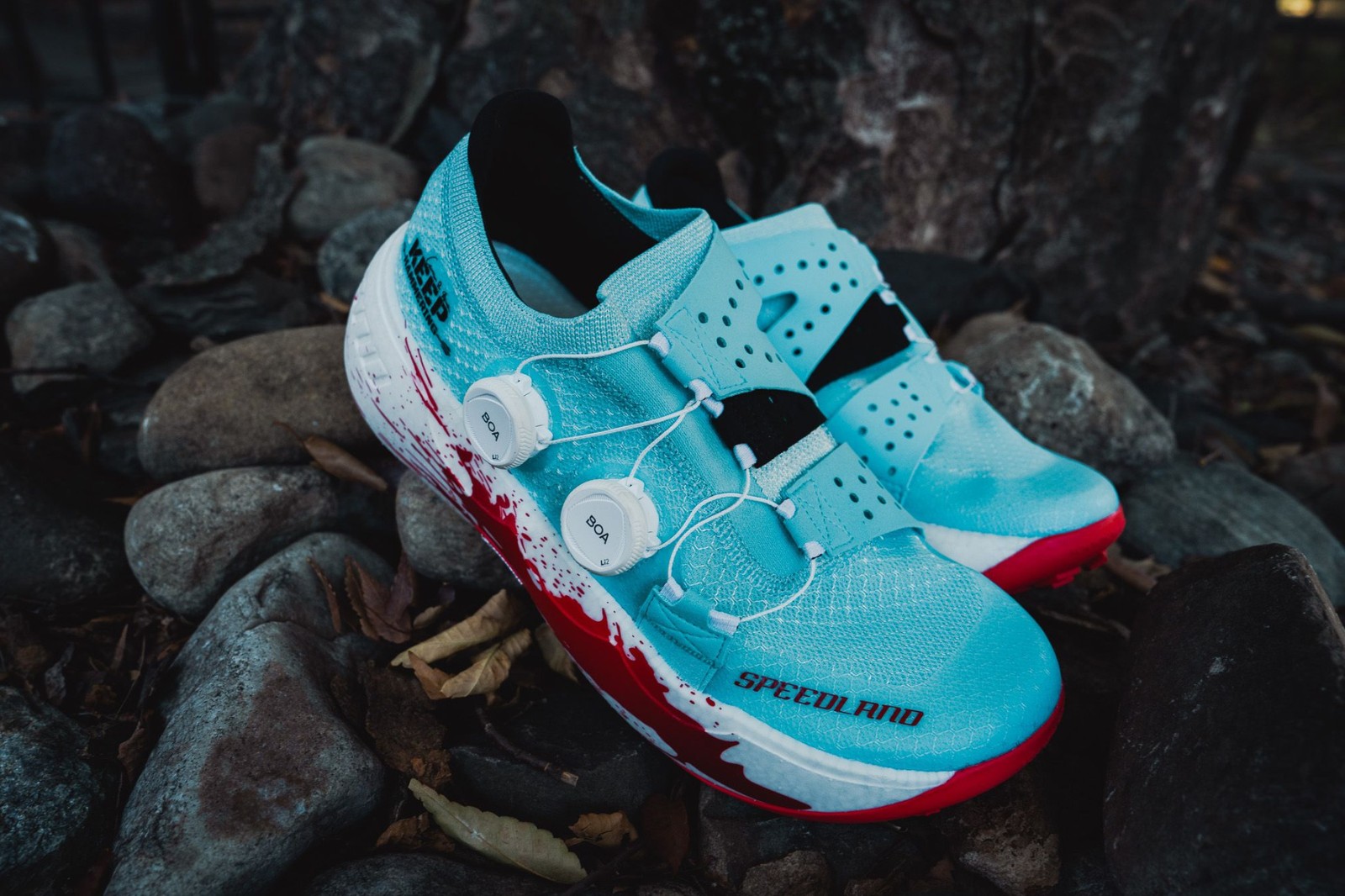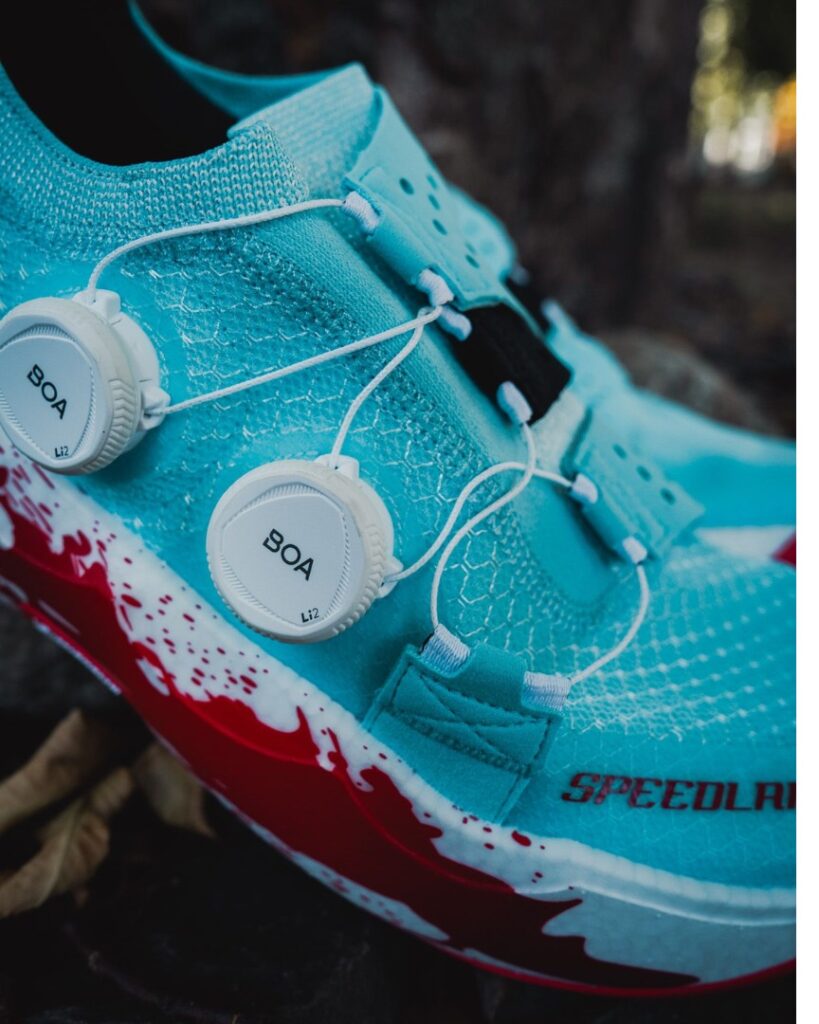

We independently review everything we recommend. When you buy through our links, we may earn a commission.
10.5 oz. (297 g) for a US M9/W10.5 (Unisex sizing)
37 mm in heel, 30 mm in forefoot (7 mm drop)
All-day trail adventures with hi-tech bounce
PerformFit upper with dual BOA dials, Michelin FiberLite outsole, Drop-in Pebax midsole
$275 (Plus $35 for the Carbitex plate)
TAYLOR: Speedland has been flipping the script in the trail running industry. While some love to hate it (probably because they don’t want to spend the money), others love it. If you’re unfamiliar with how Speedland got here, its founders, Kevin Fallon and Dave Dombrow, started from scratch after careers of having it all. In a nutshell, they shed all the red tape and budgeting to create their own passions without limits.
All of their models are essentially limited releases. So far, the designs have fallen into two main families. Kevin and Dave work with their athletes to create modified models to meet both athlete and regional demands. Their first was the SL series that’s geared toward a supreme fit and customization for the more technical side of trail running. Both the Speedland SL:PDX (Portland commission) and SL:HSV (Huntsville commission) ranked high on our overall lists when they launched.
Then came the Speedland GS (Grand Sport) series. The idea with these models is to go farther. It’s one of the few shoes available that is outright made for the demands of ultra running. The GS:TAM (Mt. Tamalpais, CA commission) stirred a lot of people’s hearts toward the brand with its outside-the-lines design and high performance.
Now, we have the latest and greatest from Speedland. The GS:PGH is the fourth edition, and it’s very similar to the GS:TAM but has a few thoughtful tweaks. It was crafted in collaboration with superstar bowhunter and all-around outdoorsman Cameron Hanes (check out our latest podcast with him here). The man is no stranger to the ultra-running world, having completed many long ultras to prepare for the demands of his own career. He’s the one who coined the Run, Lift, Shoot regimen. The GS:PGH is named after the hometown peak that he frequents, Mt. Pisgah.
I could spend time spelling out all of the updates here, but they happened to all fall into The Good category anyway — keep reading.


TAYLOR: There’s almost no way to start this other than talking about the fit. Speedland’s Boa Li2 Fit System catches the eye immediately. The two dials on Speedland shoes are about as trademark as Anthony Davis’ eyebrow, except they serve an actual function. A couple of other trail shoes, like the Altra Mont Blanc Boa and La Sportiva Jackal II Boa, utilized dual dials as well. It’s just executed so much better with Speedland’s four commissions. They were the pioneers, and with the help of the Boa team, they’ve pretty much perfected this fit system.
The broader profile of the GS:PGH works perfectly with the PerformFit wrap. It can be tightened down for performance and left loose for comfort. Going between the two is easy with the Li2 dials that don’t need to be popped, locked, and spun every time. Just twist this way or that to adjust the fit in a micro manner.
I really enjoyed the Spacer mesh upper that lies beneath the lacing system. It’s the same upper that was in the GS:TAM that has a really nice balance of comfort and toughness. TPU overlays are minimal but show up in opportune areas, like around the toe bumper and to add structure around the Boa dials. The sock-like collar and softer mesh feel awesome while maintaining durability. Compared to the Dyneema upper used in the SL series, this whole upper getup makes a lot of sense for a long-distance cruiser.
In my review of the GS:TAM, I concluded that it was the highest performance high stack shoe, and a large part of that was because of said fit. It’s really the same story here, however, the tiny adjustments made to the GS:PGH take comfort (thus performance) up one more notch. For example, the ankle collar is 5 mm lower, and the inner liner is better. Such small changes will make the difference for some runners who had some lateral ankle rubbing in the past.
Another favorite aspect is the rounded, more anatomically shaped toe box. It’s not as wide as you’d find in classic Altras like the Lone Peak 7 — the volume is closer to the width of an Altra Mont Blanc or Topo Athletic Pursuit. Still, the roundedness is what matters for comfort over the long haul. You can get even more volume by trimming the forefoot edge of the drop in the midsole, something that folks have been doing all along. Now, designers have included a trimline for guidance. I did it, and the extra millimeters of volume are noticeable and actually felt nice. I wouldn’t do this for my SL line shoes, but it was worth it for the GS:PGH and GS:TAM.
Another key component to all of Speedland’s commissions is the drop-in midsole. This Pebax is a medium-density foam with benefits like moderate levels of protection, and the cupped rim adds even more foot security.
The external midsole makes a big difference in this recipe. This is where one of the major changes occurred in this update. Speedland uses a slightly lighter and equally performance-driven HTPU beaded midsole, and many will love that it’s marginally softer than what was in the GS:TAM as well. Overall, the feel ends up as a medium/soft experience that achieves the protection needs and comfort desires trail runners would want for the long haul. It’s more of a bouncy soft rather than a cushy soft.

I would give that previous midsole talk an asterisk because I only noticed a real difference in the durometer without the Carbitex Gearflex plate involved. Adding the very lightweight (0.67 oz. or 19 g) plate made the GS:PGH ride feel just like the GS:TAM. To me, that’s fine. I like the added torsional stability, addition of a little more zip, and added degree of protection with the plate. I prefer to have it inserted in most of my runs unless I’m just picking up shorter, easy miles. Thirty-five dollars is a very reasonable price to give you a slightly different experience with noticeable performance benefits.
The Michelin Fiberlite outsole is another positive note for the GS:PGH. It’s the one component that is average. Don’t get me wrong, it gets the job done in a variety of conditions — it’s tacky — but not like Vibram Megagrip, VJ Butyl rubber, or Inov-8 Graphene Grip.
The Kings of Custom have kept the previously added modifiers to tailor the use of the GS:PGH. Elements like the aforementioned Carbitex Gearflex plate, Boa Li2 dials, the ability to trim the drop in midsole for more volume, clippable lugs to customize to connection to specific terrain, and clippable drainage holes for water egress make this one of the most customizable shoes you can buy.
Of course, the price has been a hot topic in the past few iterations. It’s worth a brief note here. Many would expect to see the price in the following section, however, $275 is pretty fair when considering the design and quality. Unless Speedland chooses to go back to the $375 tag, I don’t think I’ll waste any more time discussing the price on this. Get used to paying more for quality.
Shop Speedland GS:PGH

TAYLOR: There have been some common denominators in The Good section for all Speedland shoes, and there are common echoes in The Bad. It’s very hard to knock a shoe that is everything it claims to be.
For example, it’s lighter than the previous model… but barely. My pair of US M10.5 came in at 11.53 oz. without the plate and 12.2 ounces with. A same-size pair of GS:TAM weighed in at 11.68 oz. without or 12.28oz with. The weight change isn’t even enough to notice on foot.
On one hand, over hours and hours, a shoe of this weight can start to wear on you. On the other hand, it has performance measures to back itself up on multiple fronts. So, from an under-the-microscope perspective, weight is a negative. On foot, not as much.
With some other solid long-distance shoes like the Hoka Tecton X 2, Nike Ultrafly, and The North Face Summit Vectiv Pro coming in at less than 10 oz. in my size, the weight of the GS:PGH would make me stop and think for a bit. Granted, all of these shoes have their qualms too.
Shop Speedland GS:PGH
TAYLOR: At the end of the day, the GS:PGH and the GS:TAM are essentially the same shoe. There are some changes that boost performance up a notch, but nothing crazy. For an already highly praised long-distance trail shoe, any sort of improvements are going to come at marginal levels.
I would certainly take the GS:PGH on any of my all-day mountain forays and to race long ultras. It’s highly versatile in the sense that you can customize many parts of the shoe to fit your specific needs. Weight is the only real thing, in terms of performance, that would hold someone out from considering the Speedland GS:PGH.
The GS:PGH is also one of the few high-stack trail shoes that can roll with almost any terrain you put in front of it. This is one of the few cases where all of the quality measures equate to quality performance too.
You can pick up the Speedland GS:PGH for $275 (plus an additional $35 for the Carbitex plate) from Speedland using the buttons below.
Have something to say? Leave a Comment

Taylor Bodin is a trail and ultra runner living in Estes Park, Colo., with his wife and daughters. As the head of the Dirt Division at Believe in the Run, trail running is pretty much the only hobby he can manage right now and loves it. Every so often, he will pop off a race or FKT attempt because competition is pure and the original motivator for him getting into running anyway.
More from Taylor
“Get used to paying more for quality.” … or just be a wise consumer and wait for sales and model changes in sanely priced products before spending your hard earned money.
Great review! Couldn’t agree more, I’m tired of the price comments, too. The SL: HSV will likely last me over 1000 miles. They are built like a brick sh*thouse with performance to boot and in spades. My first pair of GS: TAM are approaching 600 miles and likely have 200 miles left on them. My GS: PGH have 150 miles and look to be even more durable than their predecessor. I’ve essentially slashed my shoe spend in half and have all the versatility I could possibly ask for with these three pairs alone. I could barely get 300 miles out of most Salomon/HOKA/Saucony shoes with what I put them through before they either failed or died (and almost always in racing scenarios! GRRRRR). That being said, if the shoes don’t work for you, then they don’t work for you; however, between the durability, quality and performance yield of Speedland’s products, the price is more than justified and the math doesn’t support anything otherwise. $375, sure. But $275? Nah, this ain’t it, fam.
I have a pair of GS:TAMs and would love to trim the front of the insole to give more room for above my big toe. How do I do that?